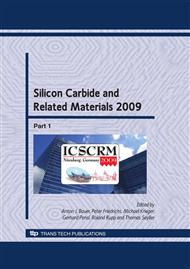p.669
p.673
p.677
p.681
p.685
p.689
p.693
p.697
p.701
Significant Improvement in Reliability of Thermal Oxide on 4H-SiC (0001) Face Using Ammonia Post-Oxidation Annealing
Abstract:
The effect of ammonia (NH3) post-oxidation annealing (POA) technique on the reliability of thermal oxides grown on a n-type 4H-SiC (0001) face by dry oxidation has been investigated. Comparing other POA techniques using hydrogen and nitrous oxide gases, it was indicated that the NH3 POA after dry oxidation remarkably improves the insulating properties of thermal oxides. The mode value of field-to-breakdown for thermal oxides prepared by NH3 POA was 12.1 MV/cm. The charge-to-breakdown (QBD) in the NH3 POA sample was the highest in all samples, and the QBD value at 63% cumulative failure rate was 19.1 C/cm2. In addition, the NH3 POA maintained excellent electron trapping characteristics of thermal oxides against the electron injection.
Info:
Periodical:
Pages:
685-688
Citation:
Online since:
April 2010
Keywords:
Price:
Сopyright:
© 2010 Trans Tech Publications Ltd. All Rights Reserved
Share:
Citation:


